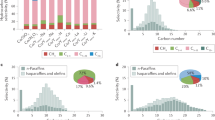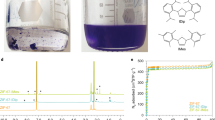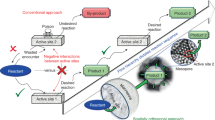Abstract
Inorganic zeolites are used for many practical applications that exploit the microporosity intrinsic to their crystal structures. Organic analogues, which are assembled from modular organic building blocks linked through non-covalent interactions, are of interest for similar applications. These range from catalysis, separation and sensor technology to optoelectronics1,2,3, with enantioselective separation and catalysis being especially important for the chemical and pharmaceutical industries. The modular construction of these analogues allows flexible and rational design, as both the architecture and chemical functionality of the micropores can, in principle, be precisely controlled. Porous organic solids with large voids and high framework stability have been produced14,15, and investigations into the range of accessible pore functionalities have been initiated7,11,12,16,17,18,19,20,21,22,23. For example, catalytically active organic zeolite analogues are known13,22,23, as are chiral metal–organic open-framework materials. However, the latter are only available as racemic mixtures24,25, or lack the degree of framework stability or void space that is required for practical applications26,27. Here we report the synthesis of a homochiral metal–organic porous material that allows the enantioselective inclusion of metal complexes in its pores and catalyses a transesterification reaction in an enantioselective manner. Our synthesis strategy, which uses enantiopure metal–organic clusters as secondary building blocks14, should be readily applicable to chemically modified cluster components and thus provide access to a wide range of porous organic materials suitable for enantioselective separation and catalysis.
This is a preview of subscription content, access via your institution
Access options
Subscribe to this journal
Receive 51 print issues and online access
$199.00 per year
only $3.90 per issue
Buy this article
- Purchase on SpringerLink
- Instant access to full article PDF
Prices may be subject to local taxes which are calculated during checkout





Similar content being viewed by others
References
Yaghi,O. M., Li,H., Davis,C, Richardson,D. & Groy, T. L. Synthetic strategies, structure patterns, and emerging properties in the chemistry of modular porous solids. Acc. Chem. Res. 31, 474–484 ( 1998).
Aoyama,Y. Functional organic zeolite analogues. Top. Curr. Chem. 198, 131–161 (1998).
Kitagawa,S. & Kondo,M. Functional micropore chemistry of crystalline metal complex-assembled compounds. Bull. Chem. Soc. Jpn 71, 1739–1753 (1998).
Janiak,C. Functional organic analogues of zeolites based on metal-organic coordination frameworks. Angew. Chem. Int. Edn Engl. 36, 1431–1434 (1997).
Abrahams,B. F., Hoskins,B. F., Michail,D. M. & Robson,R. Assembly of porphyrin building blocks into network structures with large channels. Nature 369, 727–729 (1994).
Yaghi,O. M., Li,G. & Li,H. Selective binding and removal of guests in a microporous metal-organic framework. Nature 378, 703–706 (1995).
Aoyama,Y. et al. Crystal engineering of stacked aromatic columns. Three-dimensional control of the alignment of orthogonal aromatic triads and guest quinones via self-assembly of hydrogen-bonded networks. J. Am. Chem. Soc. 118, 5562–5571 ( 1996).
Gardner,G. B., Venkataraman,D., Moore,J. S. & Lee,S. Spontaneous assembly of a hinged coordination network. Nature 374 , 792–795 (1995).
Subramanian,S. & Zaworotko,M. J. Porous solids by design: [Zn(4,4′-bipy) 2(SiF6)]n·xDMF, a single framework octahedral coordination polymer with large square channels. Angew. Chem. Int. Edn Engl. 34, 2127–2129 (1995).
Russell,V. A., Evans,C. C., Li,W. & Ward,M. D. Nanoporous molecular sandwiches: pillared two-dimensional hydrogen-bonded networks with adjustable porosity. Science 276, 575– 579 (1997).
Brunet,P., Simart,M. & Wuest,J. D. Molecular tectonics. Porous hydrogen-bonded networks with unprecedented structural integrity. J. Am. Chem. Soc. 119, 2737–2738 (1997).
Fujita,M., Kwon,Y. J., Washizu,S. & Ogura,K. Preparation, clathration ability, and catalysis of a two-dimensional square network material composed of cadmium(II) and 4,4′-bipyridine. J. Am. Chem. Soc. 116, 1151–1152 (1994).
Heo,J., Kim,S. Y., Whang,D. & Kim,K. Shape-induced, hexagonal, open frameworks: rubidium ion complexed cucurbituril. Angew. Chem. Int. Edn 38, 641–643 ( 1999).
Li,H., Eddaoudi,M., O'Keeffe,M. & Yaghi,O. M. Design and synthesis of an exceptionally stable and highly porous metal-organic framework. Nature 402, 276–279 ( 1999).
Chui,S. S.-Y., Lo,S. M.-F., Charmant,J. P. H., Orpen,A. G. & Williams,I. D. A chemically functionallizable nanoporous material [Cu3(TMA)2(H2O) 3]n. Science 283, 1148–1150 (1999).
Kiang,Y.-H., Gardner,G. B., Lee,S., Xu,Z. & Lobkovsky,E. B. Variable pore size, variable chemical functionality, and an example of reactivity within porous phenylacetylene silver salts. J. Am. Chem. Soc. 121, 8204–8215 (1999).
Gardner,G. B., Kiang,Y.-H., Lee,S., Asgaonkar,A. & Venkataraman, D. Exchange properties of the three-dimensional coordination compound 1,3,5-Tris(4-ethynylbenzonitrile)benzene·AgO3SCF 3. J. Am. Chem. Soc. 118, 6946– 6953 (1996).
Lin,K.-J. SMTP-1: the first functionalized metalloporphyrin molecular sieves with large channels. Angew. Chem. Int. Edn 38, 2730 –2732 (1999).
Li,H., Davis,C. E., Groy,T. L., Kelley,D. G. & Yaghi, O. M. Coordinatively unsaturated metal centers in the extended porous framework of Zn3(BDC)3·6CH3OH (BDC = 1,4-Benzenedicarboxylate). J. Am. Chem. Soc. 120, 2186–2187 (1998).
Reineke,T. M., Eddaoudi,M., Fehr,M., Kelley,D. & Yaghi,O. M. From condensed lanthanide coordination solids to microporous frameworks having accessible metal sites. J. Am. Chem. Soc. 121, 1651–1657 (1999).
Kondo,K., Yoshitomi,T., Seki,K., Matsuzaka,H. & Kitagawa, S. Three-dimensional framework with channeling cavities for small molecules: {[M2(4,4′-bpy)3(NO3 )4]·xH2O}n (M = Co, Ni, Zn). Angew. Chem. Int. Edn Engl. 36, 1725– 1727 (1997).
Endo,K. et al. Catalysis by organic solids. Stereoselective Diels–Alder reactions promoted by microporous molecular crystals having an extensive hydrogen-bonded network. J. Am. Chem. Soc. 119, 4117– 4122 (1997).
Sawaki,T. & Aoyama,Y. Immobilization of a soluble metal complex in an organic network. Remarkable catalytic performance of a porous dialkoxyzirconium polyphenoxide as a functional organic zeolite analogue. J. Am. Chem. Soc. 121, 4793– 4798 (1999).
Biradha,K., Seward,C. & Zaworotko, M. J. Helical coordination polymers with large chiral cavities. Angew. Chem. Int. Edn Engl. 38, 492– 495 (1999).
Decurtins,S., Schmalle,H. W., Schneuwly, P., Ensling,J. & Gütlich,P. A concept for the synthesis of 3-dimensional homo- and bimetallic oxalate-bridged networks [M2(ox) 3]n. Structural, Mössbauer, and magnetic studies in the field of molecular-based magnets. J. Am. Chem. Soc. 116, 9521–9528 (1994).
Normar,R. E., Rose,N. J. & Stenkamp, R. E. Crystal structure of a copper complex of 2-carboxypentonic acid; a decomposition product of dehydroascorbic acid. J. Chem. Soc. Dalton Trans. 2905–2910 ( 1987).
Ranford,J. D., Vittal,J. J. & Wu,D. Topochemical conversion of a hydrogen-bonded three-dimensional network into a covalently bonded framework. Angew. Chem. Int. Edn Engl. 37, 1114–1116 (1998).
Hathaway,B. J. in Comprehensive Coordination Chemistry Vol. 2 (ed. Wilkinson, G.) 439–441 (Pergamon, Oxford, 1987).
Acknowledgements
We thank the Korean Ministry of Science and Technology (Creative Research Initiatives Program) for supporting this work and the Korean Ministry of Education (Brain Korea 21 program) for graduate student fellowships (J.O. and Y.J.J.). We also thank M. G. Finn and L. K. Woo for critical reading of the manuscript.
Author information
Authors and Affiliations
Corresponding author
Supplementary information
Rights and permissions
About this article
Cite this article
Seo, J., Whang, D., Lee, H. et al. A homochiral metal–organic porous material for enantioselective separation and catalysis. Nature 404, 982–986 (2000). https://doi.org/10.1038/35010088
Received:
Accepted:
Issue Date:
DOI: https://doi.org/10.1038/35010088
This article is cited by
-
Unusually large microporous HKUST-1 via polyethylene glycol-templated synthesis: enhanced CO2 uptake with high selectivity over CH4 and N2
Environmental Science and Pollution Research (2024)
-
High-throughput screening of hypothetical metal-organic frameworks for thermal conductivity
npj Computational Materials (2023)
-
A cage-on-MOF strategy to coordinatively functionalize mesoporous MOFs for manipulating selectivity in adsorption and catalysis
Nature Communications (2023)
-
Boosting Lean Electrolyte Lithium–Sulfur Battery Performance with Transition Metals: A Comprehensive Review
Nano-Micro Letters (2023)
-
Tuning the functionality of metal–organic frameworks (MOFs) for fuel cells and hydrogen storage applications
Journal of Materials Science (2023)
Comments
By submitting a comment you agree to abide by our Terms and Community Guidelines. If you find something abusive or that does not comply with our terms or guidelines please flag it as inappropriate.



